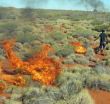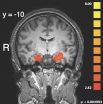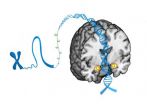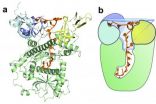WSU researchers see violent era in ancient Southwest
In long-term, peace prevails
2014-08-04
(Press-News.org) PULLMAN, Wash.—It's a given that, in numbers terms, the 20th Century was the most violent in history, with civil war, purges and two World Wars killing as many as 200 million people.
But on a per-capita basis, Washington State University archaeologist Tim Kohler has documented a particularly bloody period more than eight centuries ago on what is now American soil. Between 1140 and 1180, in the central Mesa Verde of southwest Colorado, four relatively peaceful centuries of pueblo living devolved into several decades of violence.
Writing in the journal American Antiquity, Kohler and his colleagues at WSU and at the University of Colorado-Boulder document how nearly nine out of ten sets of human remains from that period had trauma from blows to either their heads or parts of their arms.
"If we're identifying that much trauma, many were dying a violent death," said Kohler, whose study was funded by the National Science Foundation.
Yet at the same time, in the northern Rio Grande region of what is now New Mexico, people had far less violence while experiencing similar growth and, ostensibly, population pressures. Viewed together, said Kohler, the two areas offer a view into what motivates violence in some societies but not others. The study also offers more clues to the mysterious depopulation of the northern Southwest, from a population of about 40,000 people in the mid-1200s to none 30 years later.
From the days they first arrived in the Southwest in the 1800s, anthropologists and archaeologists have for the most part downplayed evidence of violent conflict among the early farmers in the region. A minority raised the specter of violence but lacked a good measure for it.
"Archaeologists with one or two exceptions have not tried to develop an objective metric of levels of violence through time," said Kohler. "They've looked at a mix of various things like burned structures, defensive site locations and so forth, but it's very difficult to distill an estimate of levels of violence from such things. We've concentrated on one thing, and that is trauma, especially to the head and portions of the arms. That's allowed us to look at levels of violence through time in a comparative way."
Meanwhile, Kohler and his colleagues are examining the role of factors like maize production, changes to the climate, and growing population in changing levels of violence. A paper of his published in June in the Proceedings of the National Academy of Sciences found that the Southwest had a baby boom between 500 and 1300 that likely exceeded any population spurt on earth today.
Both the central Mesa Verde and northern Rio Grande experienced population booms, said Kohler, but surprisingly, the central Mesa Verde got more violent while the northern Rio Grande grew less so.
Kohler offers a few explanations.
Social structures among people in the northern Rio Grande changed so that they identified less with their kin and more with the larger pueblo and specific organizations that span many pueblos, such as medicine societies. The Rio Grande also had more commercial exchanges where craft specialists provided people both in the pueblo, and outsiders, specific things they needed, such as obsidian arrow points.
But in the central Mesa Verde, there was less specialization.
"When you don't have specialization in societies, there's a sense in which everybody is a competitor because everybody is doing the same thing," said Kohler. But with specialization, people are more dependent on each other and more reluctant to do harm.
Kohler and his colleagues also cite Harvard psychologist Steven Pinker's thinking in his book, The Better Angels of Our Nature: Why Violence Has Declined.
"Pinker thought that what he called 'gentle commerce' was very important in the pacification of the world over the last 5,000 years," said Kohler. "That seems to work pretty well in our record as well."
The episode of conflict in Southwest Colorado seems to have begun when people in the Chaco culture, halfway between central Mesa Verde and northern Rio Grande, attempted to spread into Southwest Colorado.
"They were resisted," Kohler said, "but resistance was futile."
From 1080 to 1130, the Chaco-influenced people in Southwest Colorado did well. In the mid-1100s, there was a severe drought and the core of Chaco culture fell apart. Much of the area around Chaco lost population, and in 1160, violence in the central Mesa Verde peaked. Slightly more than a century later, everyone left that area, too.
"In the Mesa Verde there could be a haves-versus-have-nots dynamic towards the very end," said Kohler. "The people who stayed the longest were probably the people who were located in the very best spots. But those pueblos too were likely losing population. And it might have been the older folks who stuck around, who weren't so anxious to move as the young folks who thought, 'We could make a better living elsewhere.'" Older, or with too few people to marshal a good defense, the remaining people in the Mesa Verde pueblos were particularly vulnerable to raids.
At least two of the last-surviving large pueblos in the central Mesa Verde were attacked as the region was being abandoned. Some of their inhabitants probably made it out alive, but, says Kohler, "Many did not."
INFORMATION:
ELSE PRESS RELEASES FROM THIS DATE:
Kangaroos win when Aborigines hunt with fire
2014-08-04
SALT LAKE CITY, Aug. 4, 2014 – Australia's Aboriginal Martu people hunt kangaroos and set small grass fires to catch lizards, as they have for at least 2,000 years. A University of Utah researcher found such man-made disruption boosts kangaroo populations – showing how co-evolution helped marsupials and made Aborigines into unintentional conservationists.
"We have uncovered a framework that allows us to predict when human subsistence practices might be detrimental to the environment and when they might be beneficial," says Brian Codding, an assistant professor of anthropology.
"When ...
New trick for 'old' drug brings hope for pancreatic cancer patients
2014-08-04
Cancer Research UK scientists have found a new use for an old drug by showing that it shrinks a particular type of pancreatic cancer tumour and stops it spreading, according to research published in Gut*.
"It's a crucial step forward in developing new treatments for this devastating disease..." - Dr Jennifer Morton, study author
The scientists, at the Cancer Research UK Beatson Institute and the University of Glasgow, treated mice with pancreatic cancers caused by known genetic faults with the drug rapamycin**.
Previous clinical trials did not find this drug to be ...
Primary care telephone triage does not save money or reduce practice workload
2014-08-04
Demand for general practice appointments is rising rapidly, and in an attempt to deal with this, many practices have introduced systems of telephone triage. Patients are phoned by a doctor or nurse who either manages the problem on the phone, or agrees with the patient whether and how urgently they need to be seen.
A new large study, published in The Lancet on 4 August 2014 and funded by the UK National Institute for Health Research (NIHR), has investigated the potential value of telephone triage for patients and for the NHS. It concluded that patients who receive a telephone ...
Tumor suppressor mutations alone don't explain deadly cancer
2014-08-03
Although mutations in a gene dubbed "the guardian of the genome" are widely recognized as being associated with more aggressive forms of cancer, researchers at the University of California, San Diego School of Medicine have found evidence suggesting that the deleterious health effects of the mutated gene may in large part be due to other genetic abnormalities, at least in squamous cell head and neck cancers.
The study, published online August 3 in the journal Nature Genetics, shows that high mortality rates among head and neck cancer patients tend to occur only when mutations ...
Atlantic warming turbocharges Pacific trade winds
2014-08-03
New research has found rapid warming of the Atlantic Ocean, likely caused by global warming, has turbocharged Pacific Equatorial trade winds. Currently the winds are at a level never before seen on observed records, which extend back to the 1860s.
The increase in these winds has caused eastern tropical Pacific cooling, amplified the Californian drought, accelerated sea level rise three times faster than the global average in the Western Pacific and has slowed the rise of global average surface temperatures since 2001.
It may even be responsible for making El Nino events ...
Uncovering the 3-D structure of a key neuroreceptor
2014-08-03
Neurons are the cells of our brain, spinal cord, and overall nervous system. They form complex networks to communicate with each other through electrical signals that are carried by chemicals. These chemicals bind to structures on the surface of neurons that are called neuroreceptors, opening or closing electrical pathways that allow transmission of the signal from neuron to neuron. One neuroreceptor, called 5HT3-R, is involved in conditions like chemotherapy-induced nausea, anxiety, and various neurological disorders such as schizophrenia. Despite its clinical importance, ...
Fault trumps gruesome evidence when it comes to punishment
2014-08-03
Issues of crime and punishment, vengeance and justice date back to the dawn of human history, but it is only in the last few years that scientists have begun exploring the basic nature of the complex neural processes in the brain that underlie these fundamental behaviors.
Now a new brain imaging study – published online Aug. 3 by the journal Nature Neuroscience – has identified the brain mechanisms that underlie our judgment of how severely a person who has harmed another should be punished. Specifically, the study determined how the area of the brain that determines ...
Small DNA modifications predict brain's threat response
2014-08-03
DURHAM, N.C. -- The tiny addition of a chemical mark atop a gene that is well known for its involvement in clinical depression and posttraumatic stress disorder can affect the way a person's brain responds to threats, according to a new study by Duke University researchers.
The results, which appear online August 3 in Nature Neuroscience, go beyond genetics to help explain why some individuals may be more vulnerable than others to stress and stress-related psychiatric disorders.
The study focused on the serotonin transporter, a molecule that regulates the amount of ...
Knowing what to keep and what to trash: How an enzyme distinguishes cellular messages
2014-08-03
Cold Spring Harbor, NY – Every once in a while, we are forced to sort that stack of papers on the kitchen counter. Interspersed between the expired coupons and dozens of takeout menus are important documents like your car insurance or electric bill. So it isn't an option to simply drop it all in the trash at once – you need to read through the messages to be sure that you don't lose vital information.
In the cell, proteins similarly read through messages to distinguish what needs to be saved and what needs to be discarded. But, here, the process takes on a much more ...
Atlantic origin of recent Pacific trade wind, sea level and temperature trends
2014-08-03
An Australian–US team of climate researchers has solved a puzzle that has challenged scientists for over a decade. Climate models predict that the equatorial Pacific trades should weaken with increasing greenhouse gases. Yet, since the early 1990s, satellites and climate stations reveal a rapid and unprecedented strengthening of the Pacific trade winds, accelerating sea level rise in the western Pacific and impacting both Pacific and global climate.
"The answer to the puzzle is that recent rapid Atlantic Ocean warming has affected climate in the Pacific," say the scientists. ...
LAST 30 PRESS RELEASES:
Bluey’s dad offered professorial chair in archaeology at Griffith University
Beyond small data limitations: Transfer learning-enabled framework for predicting mechanical properties of aluminum matrix composites
Unveiling non-thermal catalytic origin of direct current-promoted catalysis for energy-efficient transformation of greenhouse gases to valuable chemicals
Chronic breathlessness emerging as a hidden strain on hospitals
Paleontologists find first fossil bee nests made inside fossil bones
These fossils were the perfect home for ancient baby bees
Not everyone reads the room the same. A new study examines why.
New research identifies linked energy, immune and vascular changes in ME/CFS
Concurrent frailty + depression likely boost dementia risk in older people
Living in substandard housing linked to kids’ missed schooling and poor grades
Little awareness of medical + psychological complexities of steroid cream withdrawal
Eight in 10 trusts caring for emergency department patients in corridors, finds BMJ investigation
NASA’s Webb telescope finds bizarre atmosphere on a lemon-shaped exoplanet
The gut bacteria that put the brakes on weight gain in mice
Exploring how patients feel about AI transcription
Category ‘6’ tropical cyclone hot spots are growing
Video: Drivers struggle to multitask when using dashboard touch screens, study finds
SLU research shows surge in alcohol-related liver disease driving ‘deaths of despair’
Rising heat reshapes how microbes break down microplastics, new review finds
Roots reveal a hidden carbon pathway in maize plants
Membrane magic: FAMU-FSU researchers repurpose fuel cells membranes for new applications
UN Member States pledge to increase access to diagnosis and inhaled medicines for the 480 million people living with COPD
Combination therapy shows potential to treat pediatric brain cancer ATRT
Study links seabird nesting to shark turf wars in Hawai‘i
Legal sports betting linked to sharp increases in violent crime, study finds
Breakthrough AI from NYUAD speeds up discovery of life-supporting microbes
New Eva Mayr-Stihl Foundation funding initiative boosts research at University of Freiburg on adaptation of forests to global change
The perfect plastic? Plant-based, fully saltwater degradable, zero microplastics
Bias in data may be blocking AI’s potential to combat antibiotic resistance
Article-level metrics would provide more recognition to most researchers than journal-level metrics
[Press-News.org] WSU researchers see violent era in ancient SouthwestIn long-term, peace prevails





